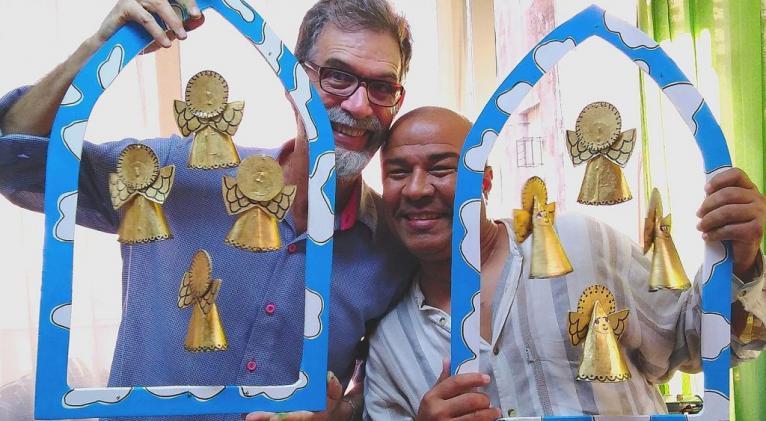With Teatro de las Estaciones, Always Beauty
especiales

The echoes of the celebrations for the 30 years of Teatro de Las Estaciones, on August 12, have not yet died down. This company always gives something to talk about. In the best regard, of course. It has become an indisputable reference for figure theater in Cuba... and beyond its borders. We spoke exclusively with its two main creators: its director, the actor and researcher Rubén Darío Salazar, and designer, Zenén Calero. Partners in work and in life, they answer this short questionnaire together.
CUBASÍ: What have been the main references for the work of the company?
RUBÉN: One is born where one is born as a professional creator and that place cannot be taken away from the Teatro Papalote. Our main reference is there, because it was there that we learned how the process of creating a show is shaped, along with how to carry out other actions that accompany the theatrical act. Indeed, you carry within you, in my case, the references of Guiñol Santiago, which I attended as a child and then the artistic work of the National Puppet Theater, in Havana, which I attended so much during my time as a student. The possibility of traveling to other countries broadened that reference, that magical connection that happens when you see the results of groups like the Philippe Genty Company, from France, or Gioco Vita, from Italy, Etcétera, Los puppet masters of Binéfar or Joan Baixas, from Spain, XPTO, from Brazil or the work of the Chilean Jaime Lorca. There are also references that are not from the field of puppet theater. He who has done theater in Cuba is not attracted by what Carlos Díaz does in his Teatro El Público? The poetics of Roberto Blanco, Berta Martínez and Vicente Revuelta. Teatro de Las Estaciones is all that: a great mix, a hotbed of connections and scenic links.
ZENÉN: My references have to do with plastic arts of course. The puppets of Bread and Puppet, by Peter Schumann, from the United States in tune with the aesthetics of maestro Armando Morales, from the National Puppet Theater. The puppets of the National Puppet Theatre in Prague with the clean lines and colours of master Jesús Ruíz. When I discovered Pepe Camejo's puppets, I knew that there was an unexplored lineage in our design, from the times of the Republic. There are also those references that Rubén talks about and that we’ve enjoyed, discussed and appreciated together. Being at the World Puppet Festival in Charleville-Mezieres, in France, and going behind the scenes to see the puppets of Taptoe Theater, from Belgium or examining the backstage of a group like the Central Puppet Theatre in Moscow, in Russia... and touching those puppets is something that can’t be forgotten.
CUBASÍ: Why is the commitment to beauty important in these times and how much does and can the company do in this regard?
RUBÉN: The commitment to beauty, which is to open a door to beauty —and I am aware of the broad spectrum at an aesthetic level this concept can hold— is important in these times and at any time. The theater has the responsibility to guide the gaze of the public, be it children, young people and adults. Bad taste, pseudo-art, crude copies of foreign influences are abundant. We cannot walk towards that ornamental chaos that does not recognize the contributions of René Portocarrero, Amelia Peláez or Alfredo Sosabravo, to speak of painting, because the same happens with literature, dance, music and cinema: there’s also beauty there. I repeat that I speak of beauty in an open range, never limited, with which spectators have, need to speak about. Las Estaciones Theater before any process investigates, inquires and finds wonders that we share. There’s no honorable task than to spread beauties; it’s like offering the most exquisite flowers from a miscellaneous garden.
ZENÉN: People always associate my work with beauty, but I think they are talking more about the care, the precision I put into every detail, the use of the color palette, the textures, the volumes and the lines without locked criteria, but experimenting and often taking risks. I don't like to be confined to a rigid definition. I’ve worked with jute and lace, with canvas and organza, with seeds and pearls. I have conceived works with the free and colorful influence of Mendive or with strong accents like the eyes that Pablo Picasso used in his human characters. I have worked with the suggestive plastic art of Sosabravo and Ares and also with the resources of impressionism. I’m a lover of the work of Joan Miró, Chagall, Klimt, to speak of foreigners, but also of what has come from the prodigious hands of Pedro Pablo Oliva, Carlos Guzmán or Ernesto Rancaño. I am a lover of beauty, I confess. I do not like botched work, laziness or disorder, I think this also identifies the creator I am, imperfect for sure, but in the eternal search for perfection.
Translated by Amilkal Labañino / CubaSí Translation Staff














Add new comment